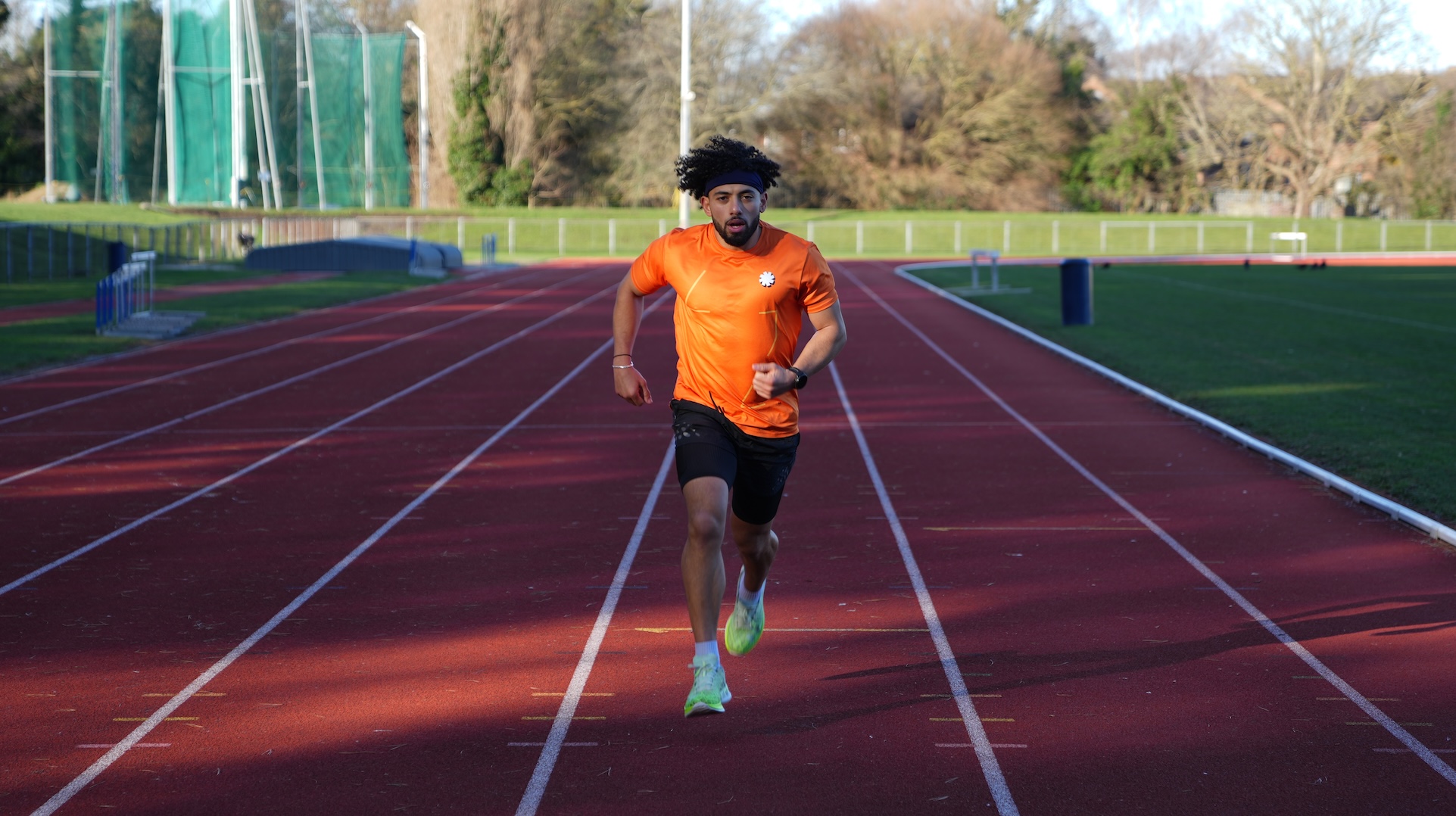What Is Interval Training For Runners?

Intervals are part of almost every training plan for runners. But why do runners do interval training and what are good interval workouts for runners?
What Is Interval Training?
Interval training means alternating between harder and easier intensities.
For runners, this most often means running a short distance at a fast speed, and then ‘recovering’ for a similar amount of time by walking or jogging. For example, you run fast for one minute, then walk for one minute.
Each faster interval, repetition or rep (different words for the same thing), is relative to your own ability and the length of the rep. You hold the appropriate effort to try and maintain your speed for the duration of the rep (so you run a 30 second interval at a faster pace than a 3 minute interval).
Interval training can be scaled as you improve as a runner. To begin you’ll only do short reps with longer recoveries, but the harder reps can increase as you become more experienced.
And just to clarify the word ‘interval’: We tend use that word for every repetition we do in training, so if we’re running a tempo workout with 3 x 15 minutes fast, we’d call the 15-minute blocks ‘intervals’. But this article specifically looks at shorter and faster intervals of up to around three minutes. When we do ‘interval training’ it’s focused on short reps.
Why Should You Do Interval Training?
Running fast over short distances can help to improve your running strength, efficiency, form and VO2 Max.
By running at different speeds, we work different energy systems in our body, and use different muscles. For example, a 10 second sprint uses muscles and energy in a very different way to a two minute hard effort. But doing both those types of runs during your training helps you to become stronger at all types of runs, including your easy runs and long runs.
Intervals help to build speed endurance, while also promoting recovery.
Let’s talk about speed first. Imagine you’re training to run a 30-minute 5km. Just trying to run 30 minutes all-out straight away is very challenging, but you can use interval training to help build up both your ability to run faster, and your capacity for endurance.
To start, that might mean running 10 x 2 minutes with a two-minute walk in between. You could progress that to 10 x 3 minutes with one minute walk recoveries. Then to 6 x 800m with a 100m walk. Then 4 x 1200m with a two minute jog. You are gradually building up the volume you run at a faster speed.
The interaction between high intensity and then recovery is very beneficial to fitness. The hard work challenges your muscles, increases your heart rate, and causes your body to produce things like lactate, which can build in your muscles and slow you down. The recovery interval allows your heart rate to come back down, it helps your body to utilise oxygen is the best way, and helps your body to clear the lactate, meaning you’re ready to run again soon. By doing this more often, your body generally gets more efficient when running, and we feel fitter.
How Often Should You Do Interval Training?
Beginner runners can try one interval session each week. Start with intervals ranging from 10 seconds to one minute and repeat up to 10 times, with a walking recovery of at least one minute between each. You can then build up from there.
As you’re running at a high intensity, it’s essential that you do a good warm up for your interval sessions. Aim for a 10-15 minute jog plus some drills and strides before beginning your intervals.
Some runners will do two interval sessions in a week, or one interval session and another faster session (like a tempo or threshold run). But you should only do two faster sessions if you are running at least four days per week or you risk doing too much faster running. Always remember the 80/20 rule where no more than 20% of your weekly running volume should be fast.
Just watch out for niggles and injuries. Running at a high intensity comes with a greater risk of injury, so always do a good warm up and drills before an interval session, and always consider an easy day or rest day after each interval training session.
How Fast Should You Run Intervals?
This is all relative to your running experience.
You should run a rep as fast as you feel comfortable doing while still being in control, and you want to be able to maintain the same pace throughout the duration of the rep. That means if you’re doing a 30 second interval you’ll run a faster pace than if you’re doing a 3 minute interval.
In general, an interval of 10 seconds to one minute should feel like an effort of 9 out of 10. Intervals from 1-3 minutes should feel like an effort of around 8 out of 10. Intervals of longer than three minutes will be more like 7 out of 10 (and these are more like tempo, threshold or VO2 Max intervals).
What Should You Do In The Recovery Between Intervals?
There are several different approaches to the recovery periods.
Some runners choose to have them as static or walking recovery, which is a good way to properly get your heart rate back down so that you are fully recovered.
Some runners choose to do an easy jog, which will also get your heartrate back down but not as low as if you are walking. Just make sure you’re still running with good form and not shuffling with bad form – if you aren’t able to jog with good form in this recovery period then walk instead.
There are also float recoveries. These are run at a more steady effort so that your heart rate remains higher.
You may also hear of over-under intervals. You might do these in training for a race where you alternate between running slightly faster than goal pace with slightly slower than goal pace. For example, if you want to do a 50-minute 10km, you might do 8 x 1km alternating between 4:45 and 5:15 pace per km (7:50 and 8:10 per mile pace).
Most of all, be flexible here. If you find that the interval reps are getting slower or that you are struggling to feel recovered, then take extra time in the recovery. The goal is always to run the rep as well as possible.
What Are Good Interval Workouts For Runners?
Here are some interval workout suggestions which can work for all levels of runners. To make these easier or harder you can reduce/increase the reps and/or the rests. Before each session make sure you have a 10-15 minute warm up and do some drills and strides.
10 x 1 Minute
Run for one minute at a fast pace, then walk for one minute. Repeat 10 times. A really good starter interval session. If you prefer, then make it a two minute walk recovery.
10 x 2 Minutes
Like 10 x 1 minutes, just longer! Take a two minute walk or jog in between to begin, and as you get stronger reduce it to a one minute recovery.
8 x 400m
Whether you’re at a track or not, run 400m (or 0.25 mile) then take a recovery of 1-2 minutes. Increase the reps if you want more work (20 x 400m is 5km of hard work).
10 x hill repeats
Adding in short, faster sprints up a hill is a great way to build more strength. Find a hill that you can run at an effort of 8-9 out of 10 for around 30 seconds. Walk back to the bottom and repeat for 10 reps. This is a good interval workout to add at the end of an easy run.
3-2-1
With a one minute walk between each rep, run three minutes, then two minutes, then one minute, making the reps faster as they get shorter. Repeat the set of 3-2-1 three times.
Mile Cut Down
On a track run 1600m then 1200m, 800m, 400m, 200m and 100m, getting faster for each rep. Take 1-2 minutes between each rep.
10 x 800m
A classic pre-marathon interval workout known as Yasso 800s, you run 800m hard then take equal recovery time (so if the rep takes four minutes, take four minutes to recover).
How Is An Interval Run Different To Tempo And Threshold Runs?
Intervals are typically shorter, faster and more intense than tempo and threshold runs.
Tempo runs are longer sustained reps from 15-60 minutes. For example, you might do 2 x 15 minutes or a 45 minute straight tempo.
Threshold runs are slightly faster than tempo runs and the reps are shorter, so between 3 and 15 minutes, with multiple reps. For example, 5 x 1 mile.
***
Do you have a favourite interval session?



























Running News
Ingebrigtsen Stars at World Athletics Indoor Championships 2025 – Plus All The Winners!
Sam Ruthe Is First 15-Year-Old To Run A Four-Minute Mile!
Eliud Kipchoge Will Run The 2025 Sydney Marathon!